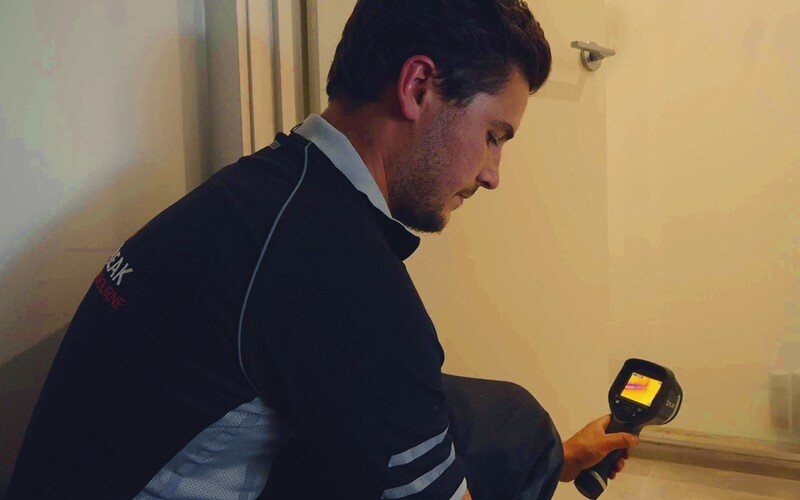Exactly how to Inspect If Your Home Has a Hidden Leakage
Exactly how to Inspect If Your Home Has a Hidden Leakage
Blog Article
We have unearthed the article about Leaking water lines directly below on the internet and believe it made perfect sense to discuss it with you on this site.

Early detection of leaking water lines can alleviate a possible calamity. Some little water leaks may not be visible.
1. Analyze the Water Meter
Every residence has a water meter. Checking it is a surefire way that helps you discover leaks. For starters, turn off all the water sources. Guarantee nobody will flush, utilize the faucet, shower, run the washing maker or dish washer. From there, most likely to the meter and also watch if it will certainly transform. Considering that no person is utilizing it, there must be no motions. That indicates a fast-moving leak if it moves. If you identify no adjustments, wait an hour or 2 and also inspect back once again. This implies you may have a slow leak that can also be below ground.
2. Examine Water Intake
Examine your water bills and track your water intake. As the one paying it, you must notice if there are any kind of inconsistencies. If you spot sudden changes, regardless of your intake coinciding, it means that you have leakages in your plumbing system. Bear in mind, your water expense need to fall under the same range each month. An unexpected spike in your bill indicates a fast-moving leakage.
A consistent increase every month, also with the same routines, reveals you have a sluggish leakage that's also gradually rising. Call a plumber to thoroughly examine your residential property, especially if you feel a cozy area on your floor with piping below.
3. Do a Food Coloring Test
When it pertains to water consumption, 30% comes from bathrooms. Test to see if they are running properly. Drop specks of food color in the storage tank and wait 10 mins. If the color somehow infiltrates your dish during that time without flushing, there's a leak between the storage tank and also bowl.
4. Asses Exterior Lines
Don't fail to remember to inspect your outside water lines too. Should water permeate out of the link, you have a loosened rubber gasket. One small leak can waste loads of water and increase your water costs.
5. Check as well as Analyze the Scenario
Homeowners need to make it a behavior to inspect under the sink counters and also inside cupboards for any bad odor or mold development. These two warnings indicate a leakage so prompt interest is required. Doing routine evaluations, even bi-annually, can save you from a significant issue.
Examine for discolorations as well as deteriorating as a lot of pipelines and also devices have a life span. If you think leaking water lines in your plumbing system, don't wait for it to intensify.
Early detection of dripping water lines can minimize a prospective calamity. Some little water leakages may not be noticeable. Examining it is a proven means that aids you find leaks. One tiny leak can lose tons of water as well as surge your water expense.
If you believe dripping water lines in your plumbing system, don't wait for it to escalate.
WARNING SIGNS OF WATER LEAKAGE BEHIND THE WALL
PERSISTENT MUSTY ODORS
As water slowly drips from a leaky pipe inside the wall, flooring and sheetrock stay damp and develop an odor similar to wet cardboard. It generates a musty smell that can help you find hidden leaks.
MOLD IN UNUSUAL AREAS
Mold usually grows in wet areas like kitchens, baths and laundry rooms. If you spot the stuff on walls or baseboards in other rooms of the house, it’s a good indicator of undetected water leaks.
STAINS THAT GROW
When mold thrives around a leaky pipe, it sometimes takes hold on the inside surface of the affected wall. A growing stain on otherwise clean sheetrock is often your sign of a hidden plumbing problem.
PEELING OR BUBBLING WALLPAPER / PAINT
This clue is easy to miss in rooms that don’t get much use. When you see wallpaper separating along seams or paint bubbling or flaking off the wall, blame sheetrock that stays wet because of an undetected leak.
BUCKLED CEILINGS AND STAINED FLOORS
If ceilings or floors in bathrooms, kitchens or laundry areas develop structural problems, don’t rule out constant damp inside the walls. Wet sheetrock can affect adjacent framing, flooring and ceilings.
https://www.servicemasterbyzaba.com/blog/how-to-detect-water-leakage-in-walls/

As a serious reader on Hacks to detect leaks, I thought sharing that post was really useful. Liked our article? Please share it. Let somebody else locate it. Thanks for your time. Come back soon.
Report this page